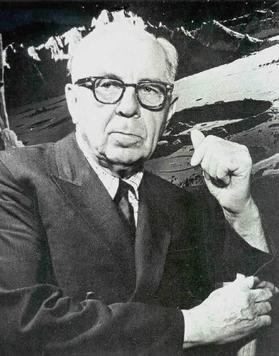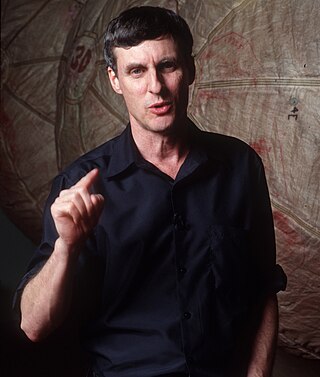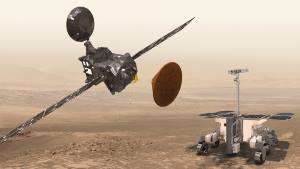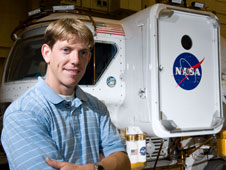Related Research Articles

Robert Zubrin is an American aerospace engineer, author, and advocate for human exploration of Mars. He and his colleague at Martin Marietta, David Baker, were the driving force behind Mars Direct, a proposal in a 1990 research paper intended to produce significant reductions in the cost and complexity of such a mission. The key idea was to use the Martian atmosphere to produce oxygen, water, and rocket propellant for the surface stay and return journey. A modified version of the plan was subsequently adopted by NASA as their "design reference mission". He questions the delay and cost-to-benefit ratio of first establishing a base or outpost on an asteroid or another Apollo program-like return to the Moon, as neither would be able to provide all of its own oxygen, water, or energy; these resources are producible on Mars, and he expects people would be there thereafter.

Chesley Knight Bonestell Jr. was an American painter, designer, and illustrator. His paintings inspired the American space program, and they have been influential in science fiction art and illustration. A pioneering creator of astronomical art, along with the French astronomer-artist Lucien Rudaux, Bonestell has been dubbed the "Father of Modern Space art".

The planet Mars has been explored remotely by spacecraft. Probes sent from Earth, beginning in the late 20th century, have yielded a large increase in knowledge about the Martian system, focused primarily on understanding its geology and habitability potential. Engineering interplanetary journeys is complicated and the exploration of Mars has experienced a high failure rate, especially the early attempts. Roughly sixty percent of all spacecraft destined for Mars failed before completing their missions and some failed before their observations could begin. Some missions have met with unexpected success, such as the twin Mars Exploration Rovers, Spirit and Opportunity which operated for years beyond their specification.

Steven Weldon Squyres is an American geologist and planetary scientist. He was the James A. Weeks Professor of Physical Sciences at Cornell University in Ithaca, New York. His research area is in planetary sciences, with a focus on large solid bodies in the Solar System such as the terrestrial planets and the moons of the Jovian planets. Squyres was the principal investigator of the Mars Exploration Rover Mission (MER).
Wind River Systems, also known as Wind River, is an Alameda, California–based company, subsidiary of Aptiv PLC. The company develops embedded system and cloud software consisting of real-time operating systems software, industry-specific software, simulation technology, development tools and middleware.

ExoMars is an astrobiology programme of the European Space Agency (ESA).
Space advocacy is supporting or advocating for a human use of outer space. Purposes advocated can reach from space exploration, or commercial use of space to even space settlement. There are many different individuals and organizations dedicated to space advocacy. They are usually active in educating the public on space related subjects, lobbying governments for increased funding in space-related activities or supporting private space activities. They also recruit members, fund projects, and provide information for their membership and interested visitors. They are sub-divided into three categories depending on their primary work: practice, advocacy, and theory.

Ted Nasmith is a Canadian artist, illustrator and architectural renderer. He is best known as an illustrator of J. R. R. Tolkien's works The Hobbit, The Lord of the Rings and The Silmarillion. Tolkien praised and commented on his early work, something that encouraged him in his career.

Colonization or settlement of Mars is the theoretical human migration and long-term human establishment of Mars. The prospect has garnered interest from public space agencies and private corporations and has been extensively explored in science fiction writing, film, and art.

Paragon Space Development Corporation is an American company headquartered in Tucson, Arizona. Paragon is a provider of environmental controls for extreme and hazardous environments. They design, build, test and operate life-support systems and leading thermal-control products for astronauts, contaminated water divers, and other extreme environment explorers, as well as for uncrewed space and terrestrial applications.

The idea of sending humans to Mars has been the subject of aerospace engineering and scientific studies since the late 1940s as part of the broader exploration of Mars. Some have also considered exploring the Martian moons of Phobos and Deimos. Long-term proposals have included sending settlers and terraforming the planet. Proposals for human missions to Mars have come from e.g. NASA, European Space Agency, Boeing, and SpaceX. As of 2023, only robotic landers and rovers have been on Mars. The farthest humans have been beyond Earth is the Moon, under the Apollo program.

The NASA Mars Design Reference Mission ("DRM") refer to a series of NASA conceptual design studies of the missions to send humans to Mars. The related term, Design Reference Architecture (DRA), refers to the entire sequences of missions and supporting infrastructure.

The Mars Exploration Joint Initiative (MEJI) is an agreement signed between United States' space agency, NASA, and Europe's space agency, ESA to join resources and expertise in order to continue the exploration of the planet Mars. The agreement was signed in Washington D.C. in October 2009, between NASA administrator Charles Bolden and ESA director-general Jean-Jacques Dordain.

Mars to Stay missions propose astronauts sent to Mars for the first time should intend to stay. Unused emergency return vehicles would be recycled into settlement construction as soon as the habitability of Mars becomes evident to the initial pioneers. Mars to Stay missions are advocated both to reduce cost and to ensure permanent settlement of Mars. Among many notable Mars to Stay advocates, former Apollo astronaut Buzz Aldrin has been particularly outspoken, suggesting in numerous forums "Forget the Moon, Let’s Head to Mars!" and, in June 2013, Aldrin promoted a crewed mission "to homestead Mars and become a two-planet species". In August 2015, Aldrin, in association with the Florida Institute of Technology, presented a "master plan", for NASA consideration, for astronauts, with a "tour of duty of ten years", to colonize Mars before the year 2040. The Mars Underground, Mars Homestead Project / Mars Foundation, Mars One, and Mars Artists Community advocacy groups and business organizations have also adopted Mars to Stay policy initiatives.
Eugene F. Lally was American aerospace engineer. He worked in the early 1960s on U.S. interplanetary space programs. Beside his space programs he was also an inventor and developed non-space products with his own company Dynamic Development Co. which he founded in the early 1960s. He later became an active amateur photographer and lubrication product entrepreneur. Lally contributed articles for popular space, astrobiology, photography, travel, and archaeology magazines. He was also a speaker at local space exploration and extraterrestrial intelligence (UFO) society meetings where he gave first-hand accounts of the early U.S. space program, commentaries on current U.S. space exploration activities and the search for extraterrestrial intelligence.

Andrew Frank Jorgensen Abercromby is a scientist and biomedical engineer who designs and tests spacesuit systems and exercise countermeasures for future exploration of the Solar System. He is employed by NASA as Lead of the Human Physiology, Performance, Protection & Operations (H-3PO) Laboratory at Johnson Space Center in Houston, Texas. As an aquanaut, Abercromby served as a member of the NASA Extreme Environment Mission Operations 14 crew. Abercromby has more than fifteen years of experience working in the Human Health and Performance (HH&P) and Engineering Directorates at the Johnson Space Center. He is married with two daughters.
William J. Clancey is a computer scientist who specializes in cognitive science and artificial intelligence. He has worked in computing in a wide range of sectors, including medicine, education, and finance, and had performed research that brings together cognitive and social science to study work practices and examine the design of agent systems. Clancey has been described as having developed “some of the earliest artificial intelligence programs for explanation, the critiquing method of consultation, tutorial discourse, and student modeling,” and his research has been described as including “work practice modeling, distributed multiagent systems, and the ethnography of field science.” He has also participated in Mars Exploration Rover mission operations, “simulation of a day-in-the-life of the ISS, knowledge management for future launch vehicles, and developing flight systems that make automation more transparent.” Clancey’s work on "heuristic classification" and "model construction operators" is regarded as having been influential in the design of expert systems and instructional programs.
Mars One was a small private Dutch organization that received money from investors by claiming it would use it to land the first humans on Mars and leave them there to establish a permanent human colony. From its announcement in 2012 to its bankruptcy in early 2019, it is estimated to have received tens of millions of dollars. The organization was not an aerospace company and did not manufacture hardware.

The Next Mars Orbiter is a proposed NASA Mars communications satellite with high-resolution imaging payload and two solar-electric ion thrusters.
References
- 1 2 3 4 Rakobowchuk, Peter (15 February 2014). "Bryan Versteeg's Mars One Illustrations Show Human Life On Another Planet". Huffington Post. Retrieved 16 February 2014.
- 1 2 3 4 5 6 "Bryan Versteeg". Mars One . Retrieved 17 November 2012.
- ↑ Versteeg, Bryan. "BVInc". Bryan Versteeg Studios Inc. Retrieved 17 November 2012.
- ↑ Lindsey, Clark S. (3 March 2013). "Bryan Versteeg illustrates the future of space development". Space-for-All. HobbySpace . Retrieved 3 March 2013.
- 1 2 "Bryan Versteeg". Fine Art America. Retrieved 16 February 2014.